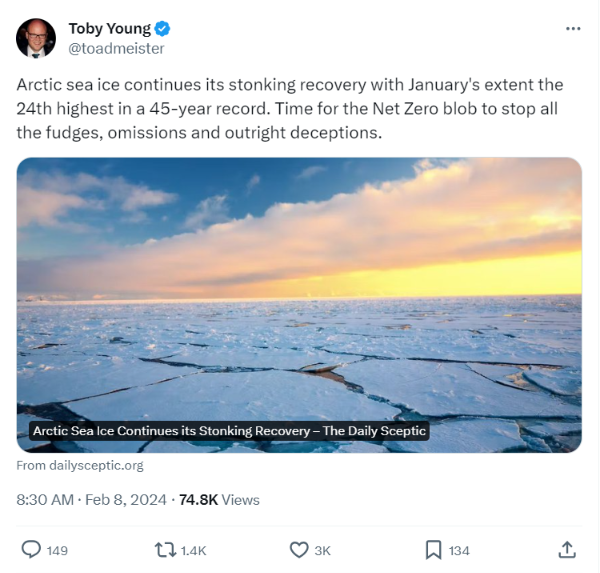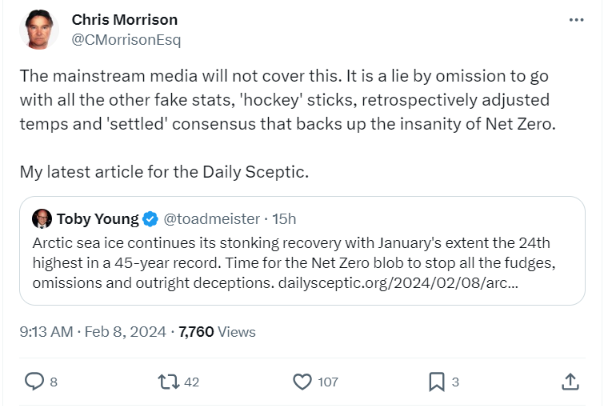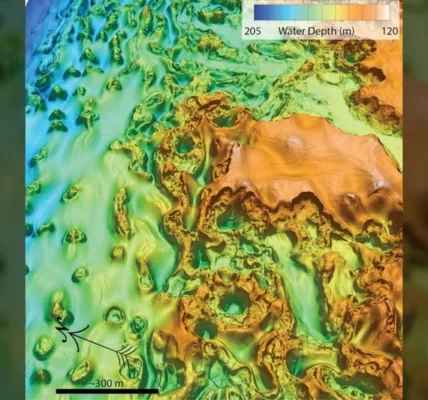As I surmised only yesterday:

The so called “skeptics” are probably already salivating over that image!
The name may not be familiar on the other side of the Atlantic, but here in the once United Kingdom Mr. Toby Young self identifies as “skeptical”, having named his web site the “Daily Sceptic”. This morning he Xweeted thus:
The linked article was written by the Daily Sceptic’s alleged “Environment Editor” Chris Morrison. Mr. Morrison Xweeted thus:
You will perhaps have already noted that Chris and Toby both appear to have an irrational fear of what they refer to as “Net Zero”? Next let’s take a look at how this fear leads Chris to “lie by omission” and indulge in “outright deceptions”.
His article begins by asserting some way above the graph at the top of this post that:
Arctic sea ice continued its stonking recovery last month, recording its 24th highest level in the 45-year modern satellite record.
If you follow that link you will perhaps notice that it takes you to an archive of the NSIDC’s Arctic Sea Ice News article entitled “Fast December expansion” which includes a different graph of Arctic sea ice extent? This one to be exact:
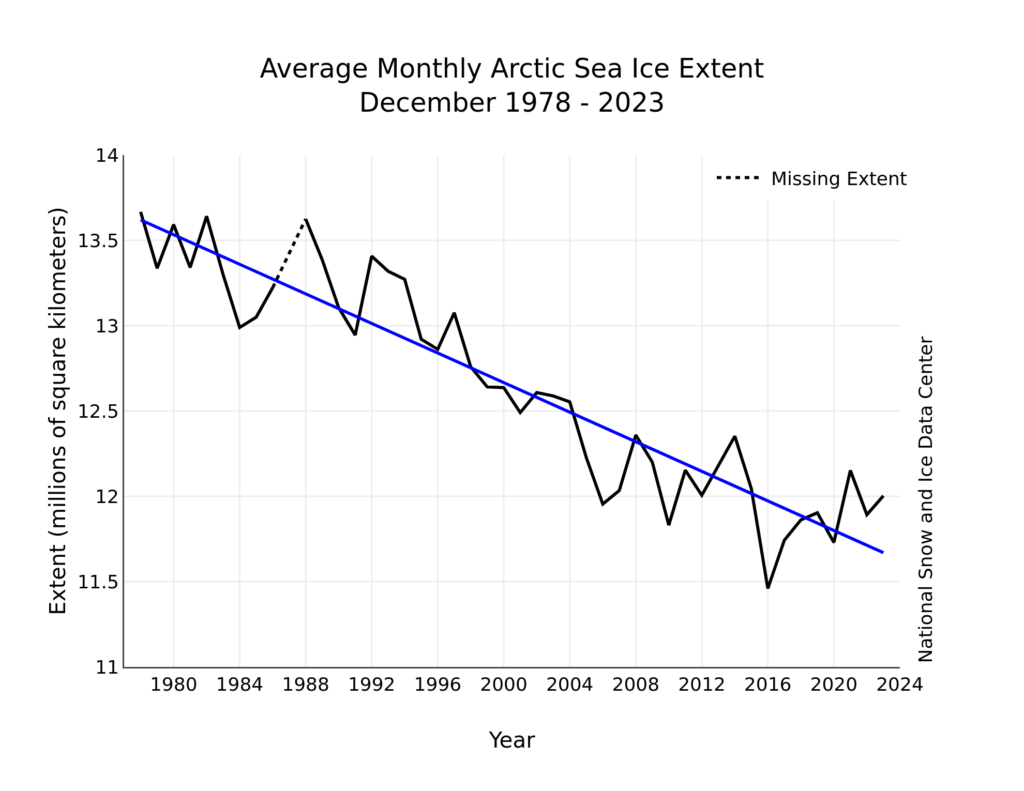
The article also notes that:
Average Arctic sea ice extent for December 2023 was 12.00 million square kilometers (4.63 million square miles), ninth lowest in the 45-year satellite record
You may ask yourself “Where on Earth did Chris and Toby pluck their ’24th highest level in the 45-year modern satellite record’ assertion from?”. A reasonable first guess might be the NSIDC article entitled “Nothing Swift about January’s Arctic sea ice” that contained the graph at the top. However that confidently states:
The year 2024 began with an average January Arctic sea ice extent of 13.92 million square kilometers (5.37 million square miles), the twentieth lowest in the 45-year satellite record.
Would you categorise these no doubt inadvertent errors as a “fudge”, or a “lie by omission”, or perhaps even an “outright deception”?
Another thing I wrote yesterday was:
However I’m willing to bet a thousand pretend pounds that they won’t publish this map as well:
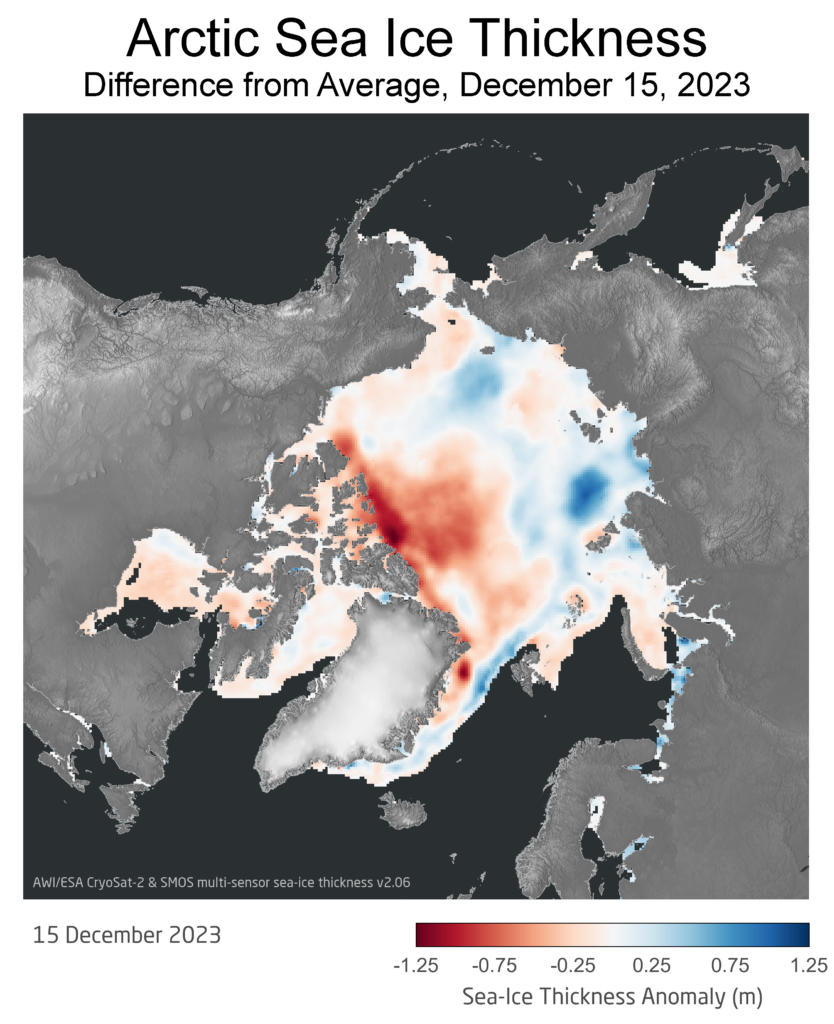
I must be psychic, because Chris and Toby did not publish that map of “measured” Arctic sea ice thickness anomaly. And unfortunately any of their flock of faithful followers that did no doubt inadvertently manage to click the convenient link still wouldn’t have seen it or its companion:

Nor would they have been able to read the accompanying text:
Sea ice thickness can be estimated from satellite-borne altimeters. Currently, two altimeters are providing thickness estimates over the Arctic Ocean. One is the NASA Ice, Cloud, Land elevation Satellite 2 (ICESat-2), a laser altimeter; ICESat-2 data products are archived at the NASA Snow and Ice Distributed Active Archive Center (DAAC) at NSIDC. The other is the European Space Agency’s (ESA’s) CryoSat-2, a radar altimeter. In combination with estimates for thin regions from the ESA Soil Moisture Ocean Salinity (SMOS) satellite, CryoSat-2 provides daily updated weekly average thickness.
As Arctic sea ice extent starts approaching its maximum, ice thickness can provide an indication of the state of the ice cover. The most recent (mid-December 2023) thickness analysis from the ESA SMOS & CryoSat-2 Sea Ice Data Product Processing and Dissemination Service at Alfred Wegener Institute indicates up to 1.25 meters (4.1 feet) thicker ice than the 2011 to 2023 average over the Siberian side of the Arctic, with ice on the North American side up to 1.25 meters (4.1 feet) thinner than average. This suggests that there may be a slower melt out of ice in the Siberian coastal seas, but perhaps faster in the Beaufort Sea
How much faith do you suppose one should put in the rest of Mr. Morrison’s purple prose, which includes such gems as:
As reported previously in the Daily Sceptic, the ice climbed to a 21-year high on January 8th. Good news, of course, for ice fans and polar bears, but frankly a bit of a disaster if you are forecasting future summer swimming galas at the North Pole to promote a collectivist Net Zero agenda.
and no doubt inadvertently mocks the greatest living British national treasure as follows:
The recovery in Arctic sea ice has been steady if slow and this has enabled the alarums to hang on in the mainstream headlines. Of course it could go into reverse, nobody really knows, least of all Sir David Attenborough who told BBC viewers in 2022 that the summer ice could all be gone by 2035. He relied, needless to say, on a computer model.
That was obviously a slip of the virtual typesetter’s inky finger. It should of course have read:
Least of all Chris Morrison and Toby Young.
since it remains a mystery where their “24th highest level in the 45-year modern satellite record” assertion originated. Your suggestions are welcome, in the space provided for that purpose below.
To be continued…
